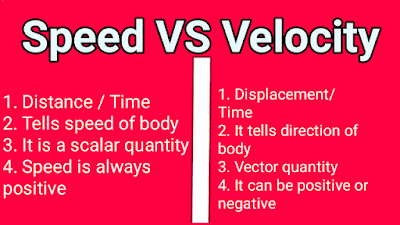Speed, velocity, and acceleration describe the motion of a body. But there is a difference between speed, velocity, and acceleration. The rate at which a body moves is its speed. We can define speed as the distance traveled by a body in unit time. On the other hand, the velocity of a body tells us how fast a body is moving in a particular direction. We can define velocity as the time rate of change of displacement of a body. If we talk about acceleration, we come to know that the time rate of change of velocity is acceleration. Here, we will briefly explain speed, velocity, and acceleration.
What is Speed?
As we have discussed earlier the distance traveled by a body in unit time is its speed. It is a scalar quantity because it is completely described by its magnitude. We don’t require direction to describe it. If the speed of an object is higher, it means that it is moving at a faster rate. If the speed of an object is lower, it means that it is moving at a slower speed. As the SI unit of distance is ‘m’. The SI unit of time is ‘s’. Therefore, the SI unit of speed is ‘m/s’.
Formula to Calculate the Speed
We can easily calculate the speed of an object by using the following formula.
r= d/t
Here, r is the speed and d is the distance traveled. We have used ‘t’ to represent the time taken by the body to travel this distance.
Numerical relevant to speed
A cyclist covers a distance of 200 meters in 20 seconds, find out its speed.
Solution:
Distance traveled by the cyclist = 200 meters
Time taken to travel this distance = 20 seconds
Speed = Distance / Time
= 200/20
Speed = 10 m/s
What is the Velocity?
The time rate of change of displacement of a body is its velocity. The velocity of a body tells us how fast a body is moving in a particular direction. Therefore, velocity is a vector quantity because there requires magnitude as well as direction for its complete description. SI unit of velocity is m/s.
Uniform Velocity
If a body covers equal displacement in equal intervals of time, we can say that it is moving with uniform velocity. The graph of uniform velocity gives us a straight line.
Variable Velocity
If a body covers unequal displacement in equal intervals of time, it has variable velocity. The graph of variable velocity doesn’t give us a straight line.
Formula to Calculate the Velocity
We can calculate the velocity of an object by using the following formula;
Velocity = Displacement / Time
Numerical Relevant to Velocity
If a man walks 300 m in the East in 100 seconds, find out its velocity.
Solution:
Displacement = 300m
Time = 100 seconds
Velocity = Displacement / Time
= 300/100 Velocity
= 3 m/s
Difference between Speed and Velocity
After getting an idea about speed and velocity, we can compare these two quantities. Here, we will describe the difference between speed and velocity.
1. Difference between Meanings of Speed and Velocity
The first difference between speed and velocity is in their meanings. The meaning of speed is the distance covered by a body in unit time. On the other hand, the meaning of velocity is the displacement covered by a body in unit time.
2. Speed and Velocity Indicate Different Things
The speed of a body tells us how fast a body is moving. On the other hand, the velocity of a body tells us how fast and in which direction a body is moving.
3. Speed and Velocity are Two Different Quantities
Speed is a scalar quantity because we don’t require direction for its complete description. Velocity is a vector quantity because there requires magnitude as well as direction for its complete description.
4. Change of Direction
The speed of an object is always positive. On the other hand, the velocity of an object can be positive or negative. It means that we can’t change the direction of the speed of a body. On the other hand, we can change the direction of the velocity of a body.
5. Magnitude
The magnitude of the velocity of a body can be zero, positive, or negative. On the other hand, the magnitude of the speed of a body is always positive. In other words, the magnitude of the speed of a body can never be negative or zero.
6. The interrelation between Speed and Velocity
We can also inter-relate speed and velocity. After inter-relating speed and velocity, we know that the speed of a body may or may not be equal to its velocity. On the other hand, an object may possess different velocities but its speed remains the same.
7. Units of Speed and Velocity
To measure both speed and velocity, we use the same unit. We use ‘m/s’ to measure both speed and velocity of a body.
8. Equations
Speed and velocity have different equations. To measure the velocity of a body, we use the equation ‘∆x/∆t’. This equation gives us the average velocity of a body. On the other hand, to measure the speed of a body, we use the equation d/t.
9. Calculations
We use two different techniques to calculate the speed and velocity of a body. To calculate the velocity of a body, we divide displacement over time. On the other hand, to calculate the speed of a body, we divide distance over time.
10. Examples
Most of the students don’t know the examples of speed and velocity. If we calculate the different speeds of a sports bike, the average speed of the bike gives us the speed of the bike. On the other hand, if a train moves in a particular direction, its average speed will be its velocity. You may also like to read about the difference between mass & weight and the difference between rational & irrational numbers.
What is the Acceleration?
The time rate of change of velocity is its acceleration. Acceleration is a vector quantity because there requires magnitude as well as direction for its complete description. If the velocity of a body is increasing, its acceleration is positive. On the other hand, if the velocity of a body is decreasing, its acceleration is negative. The unit of acceleration is a meter per Second Square. We use the following formula to measure the acceleration.
Acceleration = Velocity / Time
Uniform Acceleration
If the velocity of an object is the same in equal intervals of time, it has uniform acceleration. If we draw a graph between velocity and time, we get a straight line.
Variable Acceleration
If the velocity of an object is changing in equal intervals of time, it has variable acceleration. If we draw a graph between velocity and time, we can’t get a straight line.
Numerical Relevant to Acceleration
If a car starts from zero and gains a velocity of 36km/h after 20 seconds, find out its acceleration.
Solution:
As we know that km/h is not the SI unit of velocity. Therefore, before solving it, we have to convert it into its SI unit. Its SI unit is m/s.
Velocity = 36km/h
= 10 m/s
Time = 20 seconds
Acceleration = Change in velocity/time
= 10 – 0 / 20
Acceleration = 0.5 meters per second square
Difference between Velocity and Acceleration
While studying motion, we have to come across velocity and acceleration. Most of the students don’t understand the difference between velocity and acceleration. Here, we will discuss the key differences between velocity and acceleration.
1. Difference between Meanings of Velocity and Acceleration
There is a difference between the meanings of velocity and acceleration. The velocity of an object is implied by the speed of an object. On the other hand, the acceleration of an object is implied by the change in the velocity.
2. Difference between Definitions of Velocity and Acceleration
There is also a difference between the definitions of velocity and acceleration. We define velocity as the rate of change in displacement. On the other hand, the acceleration of an object is defined as the time rate of change in velocity.
3. Velocity and Acceleration Indicate Different Things
The velocity of an object tells us the speed and moving direction of an object. On the other hand, the acceleration of an object tells us how the velocity of an object is changing.
4. Velocity and Acceleration have Different Methods of Calculation
We can find the velocity of an object by dividing displacement over time. On the other hand, we can find acceleration by dividing velocity over time.
5. Units of Velocity and Acceleration
The unit of velocity is a meter per second. On the other hand, the unit of acceleration is a meter per Second Square.
6. Formula
The formula of velocity is (d/t). On the other hand, the formula of acceleration is (v/t).
7. Ascertains
With the help of velocity and acceleration, we can make different ascertains. By calculating velocity, we can get an idea of how fast an object is moving. Moreover, it also tells the direction of the movement of the object. On the other hand, the acceleration of an object tells how fast the velocity of an object is changing relevant to the time.
8. In Other Terms
If we multiply the velocities of an object by its mass, we will get its momentum (p=mv). On the other hand, if we multiply the acceleration of an object by its mass, we will get the applied force (f=ma).
9. Quantities
Both velocity and acceleration are vector quantities. Its reason is that to measure these two quantities, we use magnitude as well as direction.
10. Difference between Magnitudes of Velocity and Acceleration
As we have discussed earlier that the magnitude of a velocity can be negative, positive, or zero. On the other hand, the magnitude of acceleration can also be positive or negative but it can never be zero. Its reason is to find the acceleration of a body, there should be some motion in the body.








AWSM Information, Keep Making Good Nd Informative Stuff Like This��������